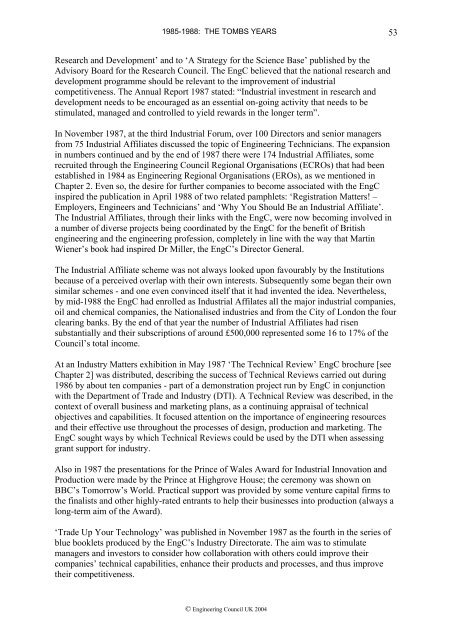An Engine for Change - A Chronicle of the Engineering Council
An Engine for Change - A Chronicle of the Engineering Council
An Engine for Change - A Chronicle of the Engineering Council
Create successful ePaper yourself
Turn your PDF publications into a flip-book with our unique Google optimized e-Paper software.
1985-1988: THE TOMBS YEARS 53Research and Development’ and to ‘A Strategy <strong>for</strong> <strong>the</strong> Science Base’ published by <strong>the</strong>Advisory Board <strong>for</strong> <strong>the</strong> Research <strong>Council</strong>. The EngC believed that <strong>the</strong> national research anddevelopment programme should be relevant to <strong>the</strong> improvement <strong>of</strong> industrialcompetitiveness. The <strong>An</strong>nual Report 1987 stated: “Industrial investment in research anddevelopment needs to be encouraged as an essential on-going activity that needs to bestimulated, managed and controlled to yield rewards in <strong>the</strong> longer term”.In November 1987, at <strong>the</strong> third Industrial Forum, over 100 Directors and senior managersfrom 75 Industrial Affiliates discussed <strong>the</strong> topic <strong>of</strong> <strong>Engine</strong>ering Technicians. The expansionin numbers continued and by <strong>the</strong> end <strong>of</strong> 1987 <strong>the</strong>re were 174 Industrial Affiliates, somerecruited through <strong>the</strong> <strong>Engine</strong>ering <strong>Council</strong> Regional Organisations (ECROs) that had beenestablished in 1984 as <strong>Engine</strong>ering Regional Organisations (EROs), as we mentioned inChapter 2. Even so, <strong>the</strong> desire <strong>for</strong> fur<strong>the</strong>r companies to become associated with <strong>the</strong> EngCinspired <strong>the</strong> publication in April 1988 <strong>of</strong> two related pamphlets: ‘Registration Matters! –Employers, <strong>Engine</strong>ers and Technicians’ and ‘Why You Should Be an Industrial Affiliate’.The Industrial Affiliates, through <strong>the</strong>ir links with <strong>the</strong> EngC, were now becoming involved ina number <strong>of</strong> diverse projects being coordinated by <strong>the</strong> EngC <strong>for</strong> <strong>the</strong> benefit <strong>of</strong> Britishengineering and <strong>the</strong> engineering pr<strong>of</strong>ession, completely in line with <strong>the</strong> way that MartinWiener’s book had inspired Dr Miller, <strong>the</strong> EngC’s Director General.The Industrial Affiliate scheme was not always looked upon favourably by <strong>the</strong> Institutionsbecause <strong>of</strong> a perceived overlap with <strong>the</strong>ir own interests. Subsequently some began <strong>the</strong>ir ownsimilar schemes - and one even convinced itself that it had invented <strong>the</strong> idea. Never<strong>the</strong>less,by mid-1988 <strong>the</strong> EngC had enrolled as Industrial Affilates all <strong>the</strong> major industrial companies,oil and chemical companies, <strong>the</strong> Nationalised industries and from <strong>the</strong> City <strong>of</strong> London <strong>the</strong> fourclearing banks. By <strong>the</strong> end <strong>of</strong> that year <strong>the</strong> number <strong>of</strong> Industrial Affiliates had risensubstantially and <strong>the</strong>ir subscriptions <strong>of</strong> around £500,000 represented some 16 to 17% <strong>of</strong> <strong>the</strong><strong>Council</strong>’s total income.At an Industry Matters exhibition in May 1987 ‘The Technical Review’ EngC brochure [seeChapter 2] was distributed, describing <strong>the</strong> success <strong>of</strong> Technical Reviews carried out during1986 by about ten companies - part <strong>of</strong> a demonstration project run by EngC in conjunctionwith <strong>the</strong> Department <strong>of</strong> Trade and Industry (DTI). A Technical Review was described, in <strong>the</strong>context <strong>of</strong> overall business and marketing plans, as a continuing appraisal <strong>of</strong> technicalobjectives and capabilities. It focused attention on <strong>the</strong> importance <strong>of</strong> engineering resourcesand <strong>the</strong>ir effective use throughout <strong>the</strong> processes <strong>of</strong> design, production and marketing. TheEngC sought ways by which Technical Reviews could be used by <strong>the</strong> DTI when assessinggrant support <strong>for</strong> industry.Also in 1987 <strong>the</strong> presentations <strong>for</strong> <strong>the</strong> Prince <strong>of</strong> Wales Award <strong>for</strong> Industrial Innovation andProduction were made by <strong>the</strong> Prince at Highgrove House; <strong>the</strong> ceremony was shown onBBC’s Tomorrow’s World. Practical support was provided by some venture capital firms to<strong>the</strong> finalists and o<strong>the</strong>r highly-rated entrants to help <strong>the</strong>ir businesses into production (always along-term aim <strong>of</strong> <strong>the</strong> Award).‘Trade Up Your Technology’ was published in November 1987 as <strong>the</strong> fourth in <strong>the</strong> series <strong>of</strong>blue booklets produced by <strong>the</strong> EngC’s Industry Directorate. The aim was to stimulatemanagers and investors to consider how collaboration with o<strong>the</strong>rs could improve <strong>the</strong>ircompanies’ technical capabilities, enhance <strong>the</strong>ir products and processes, and thus improve<strong>the</strong>ir competitiveness.© <strong>Engine</strong>ering <strong>Council</strong> UK 2004
















